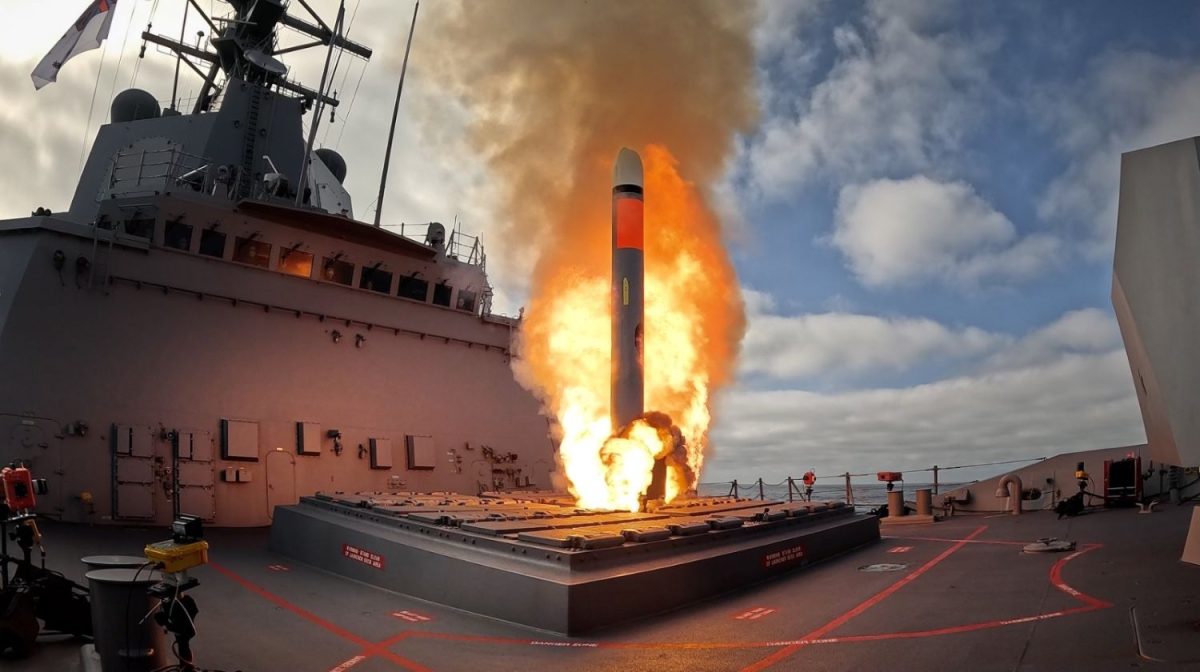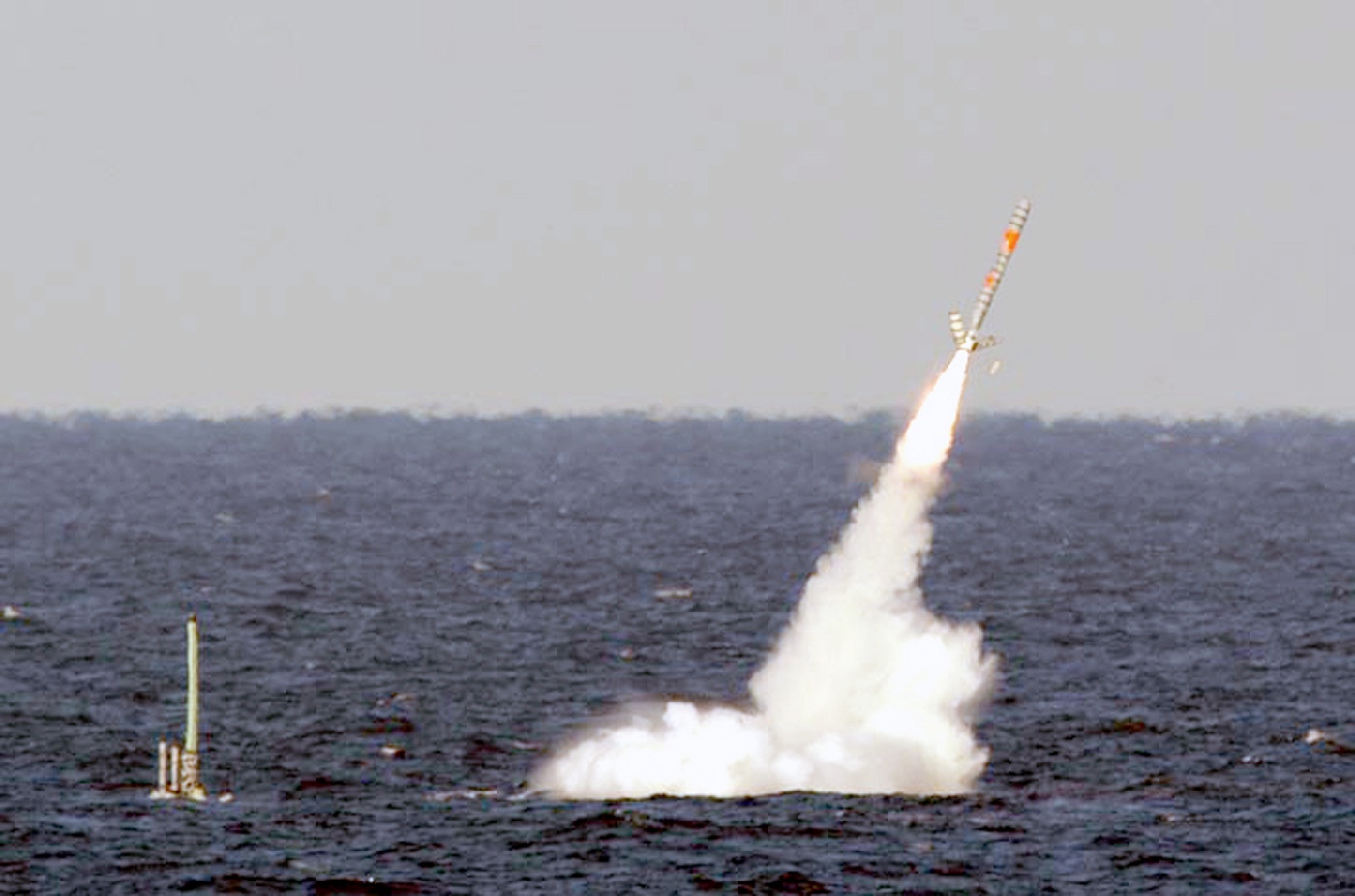The Tomahawk Land Attack Missile (TLAM), a staple of the US precision strike capabilities, has surged back into headlines in 2025 due to a confluence of high-stakes geopolitical moves. This includes its integration onto Japanese warships, a potential delivery to Ukraine, and its use by the US Navy against Iran.
In a major push for Japan’s long-standing goal of equipping its warships with long-range land-attack capability, the JS Chokai is sailing to the United States for modifications required to arm it with the deadly Tomahawk missiles. This was announced by the Japanese Ministry of Defense (MoD) in a post on X earlier this week.
Chokai is a Kongo-class guided missile destroyer and one of the eight Aegis destroyers in the Japanese inventory. Japan’s eight Aegis destroyers—two Kongo class, two Atago class, two Maya class, and the two new destroyers that will be put into service in 2027 and 2028—will all have Tomahawks installed on them.
The ministry plans to gradually refurbish all eight Aegis destroyers that are stationed at the Japan Maritime Self-Defense Force (JMSDF) bases in Sasebo, Kanagawa Prefecture, and Yokosuka, Kanagawa Prefecture.
The chosen destroyer trained to load missiles at Yokosuka Base last week using dummy Tomahawk rounds ahead of its journey to the US. “The training was conducted to familiarize the ship with the procedures required for Tomahawk operation and to confirm the safety management system,” the Japanese Ministry of Defense said at the time.
To acquire Tomahawk launch capabilities, #JS_CHOKAI will undergo modifications and conduct crew training from Sep 26 2025 to mid-Sep 2026 in the U.S.
Prior to departure, CHOKAI conducted a #Tomahawk dummy munition loading training. https://t.co/rme5v3hu8Q pic.twitter.com/WQrYKMOY6E— Japan Ministry of Defense/Self-Defense Forces (@ModJapan_en) September 29, 2025
Notably, the Kongo class’s Mk 41 vertical launch system (VLS) cells are already big enough to accommodate the Tomahawk.
The modifications on the ship and crew training will be conducted at San Diego, California, and are expected to conclude by mid-September 2026.
The first batch of Tomahawk missiles is expected to be delivered to Japan before the end of March 2026. A live-fire test is anticipated by the summer of the same year to assess the crew’s competence and the ship’s readiness for operational missions.
Japan signed an agreement with the US for the purchase of 400 Tomahawk long-range cruise missiles in 2024, as reported by the EurAsian Times at the time.
The purchase agreement reportedly includes 200 Block IV Tomahawks, 200 Block V Tomahawks, 14 Tactical Tomahawk Weapon Control Systems, support, training, maintenance, spares, and other peripheral services.
The acquisition of these deadly missiles corresponds with the government’s National Security Strategy, which calls for counter-strike capabilities. With longer-range missiles at its disposal, Japan will have the capability to target areas across North Korea and parts of eastern and northeastern China from its territorial waters, amid burgeoning security threats in the region.

The Japanese Defense Ministry’s annual white paper, released in July, said that China’s military activities present “the greatest strategic challenge” to Japan.
Tokyo has repeatedly raised concerns about the increase in Chinese military operations in the vicinity of Japan and Taiwan in recent years, cautioning that this situation may escalate, given Japan’s close geographical proximity to the self-governing island of Taiwan. Once deployed, the Tomahawks will improve “standoff defense capabilities to intercept and eliminate invading forces against Japan at a rapid pace and at long range.”
In addition to this, the Tomahawk currently sits in the Philippines as part of the Mid-Range Capability (MRC) missile system and has been acquired by Australia, all aimed at deterring China.

The US is also currently mulling the possibility of arming Ukraine with Tomahawk missiles, as confirmed by US Vice President J.D. Vance on September 28.
“It’s something the president is going to make the final determination on. What the president is going to do is what’s in the best interest of the United States of America,” Vance told Fox News in an interview. “I know we’re having conversations this very minute about the issue,” he stated.
The statement came shortly after reports suggested that the Ukrainian President Volodymyr Zelenskyy had requested the Tomhawk missile during a meeting with US President Donald Trump on September 26. Interestingly, Zelenskyy has been lobbying for the missiles since October 2024, and the “Victory Plan” presented to the former Biden administration included the Tomahawk missiles.
US Vice President JD Vance said that Washington is considering Ukraine's request for long-range Tomahawk missiles to counter Russia. Kyiv could strike deeper into Russia if it is provided with Tomahawk cruise missiles https://t.co/6H8HeZyTG8 pic.twitter.com/aWf5A4awB9
— Reuters (@Reuters) September 30, 2025
Vance’s comments also correspond with US President Donald Trump’s envoy, Keith Kellogg, floating the possibility of long-range strikes by Ukraine against Russia with American weapons, demonstrating a clear shift in strategy.
The Tomahawk missiles will allow Ukraine to hit targets deep inside Russia with enhanced precision, a capability that will allow it to build pressure on Moscow. Currently, Kyiv utilizes long-range drones to conduct such strikes.
The potential delivery of Tomahawk was ridiculed by Russia. Kremlin spokesperson Dmitry Peskov said in a press briefing on September 29 that there was “no panacea that can change the situation on the front for the Kyiv regime.” “There’s no magic weapon. Whether it’s Tomahawks or other missiles, they won’t be able to change the dynamic.”
However, there is a growing opinion that Russia is likely just rattled by the possibility of long-range Tomahawks raining on it.
Operational for decades, the Tomahawks shot to glory once again this year when the United States Air Force (USAF) used them to launch precision strikes inside Iran as part of Operation Midnight Hammer in June 2025.
The US Navy launched 30 Tomahawks from an Ohio-class guided-missile nuclear submarine positioned in the Arabian Sea or Persian Gulf. These were supplemented by strikes from seven B-2 Spirit stealth bombers dropping 14 GBU-57 Massive Ordnance Penetrator (MOP) bunker-buster bombs.
The Tomahawks are being used to deter all major enemies of the United States across the world, including China, Russia, Iran, and North Korea.
Tomahawks: Deadly Precision Missiles
The Tomahawk missile is a long-range, all-weather, subsonic cruise missile that was developed in the 1970s to address the demands of modern combat. With advanced design features, precision, and operational flexibility, the Tomahawk is considered one of the most formidable weapons in the world.
Produced by Raytheon (RTX Corporation), the missile is primarily designed to conduct strikes against high-value, heavily defended land targets, such as command centers, airfields, and critical infrastructure. The Tomhawk is a highly versatile weapon because it can be launched from surface ships, submarines, and occasionally ground-based launchers.
The Block III/IV variant of the missile has a range of about 1,600 kilometres, whereas the newer Block V variant can hit targets over 1,800 kilometres away.
In essence, the Tomahawk is designed to deliver a powerful payload over long distances with high accuracy, minimizing risk by enabling standoff strikes, which is imperative in modern combat where airspace is saturated with layered air defense.
Notably, the Block IV version features an integrated datalink that enables target switching during flight and allows it to hover for an extended period. On the other hand, the Block V variant incorporates advanced technological innovations that allow the weapon to engage moving maritime targets while airborne, maintaining a low altitude that evades detection by adversaries’ radar systems.

Block IV and V missiles can change targets mid-flight, loiter over an area, or transmit imagery for battle damage assessment.
Tomahawk has undergone continuous upgrades over the years to enhance its lethality. More than a dozen versions have been unveiled since its debut, with an eye on enhancing accuracy, range, and versatility. It works in conjunction with other systems, such as Aegis-equipped ships and networked command systems, enabling coordinated strikes.
The operational strength of the Tomahawk is derived from its ability to fly at low altitudes to evade radar detection, utilize terrain-following radar, and hover over targets, such as unmanned aerial vehicles (UAVs).
Tomahawk cruise missiles can inflict significant damage, destroying structures and creating explosive craters up to 20 feet in width. Its ability to transport a standard warhead, weighing approximately 450 kilograms, makes it a very deadly weapon. Moreover, it has a Circular Error Probable (CEP) of about 10 meters or less, which means that it can hit within a 10-meter radius of the target.
The missile has been used in the past across diverse battlefields, including in the Gulf War of 1991, Afghanistan, Libya, and Syria. In 2023, the US Navy awarded Raytheon a $1.4 billion contract to produce and upgrade Block IV and V missiles through 2028, ensuring their continued operational capability for an extended period.
- Contact the author at sakshi.tiwari9555 (at) gmail.com
- Follow EurAsian Times on Google News




